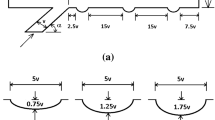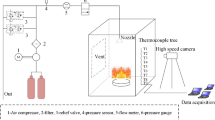Abstract
A cooling system that sprays micro water droplets could prove useful in mitigating temperature increases in urban areas by using the heat of water evaporation, a process that consumes only small amounts of water and energy. If water mist is sprayed in a semi-outdoor area, for example, under a canopy, it could potentially improve conditions on hot days. However, there is little reference data concerning the design or control of such systems. In order to propose a method for designing and predicting the performance of a water mist system, we discuss differences in cooling effects in the context of particle size distribution of water mist. The results of numerical fluid analysis showed there is no significant difference in temperature reduction for different particle sizes. However, the water particles remained in a lower position with larger particles.
Similar content being viewed by others
Abbreviations
- a gs :
-
solar absorptance at ground surface (−)
- A :
-
surface area (m2)
- c :
-
heat capacity (J/(kg·K))
- d :
-
droplet diameter (m)
- d L :
-
ligament diameter (m)
- d inj :
-
injector orifice diameter (m)
- d 0 :
-
most probable droplet size (m)
- d ug :
-
depth (m)
- d :
-
size constant (m)
- ƒ D :
-
drag force coefficient (s−1)
- ƒ x :
-
additional force coefficient (m/s2)
- F :
-
momentum (N·m/s)
- h :
-
film thickness (m)
- J :
-
horizontal solar radiation (W/m2)
- k m :
-
mass transfer coefficient (m/s)
- K b :
-
the most unstable wavelength (s−1)
- l :
-
latent heat (J/kg)
- L b :
-
breakup length (m)
- m :
-
mass (kg)
- ṁ:
-
mass flow rate (kg/s)
- M :
-
molecular weight (kg/mol)
- n :
-
spread parameter of a Rosin-Rammler distribution (−)
- N :
-
molar flux of vapor (mol/(m2·))
- Oh :
-
Ohnesorge number
- p :
-
vapor pressure (Pa)
- q cond :
-
heat diffusion to the underground (W/m2)
- q conv :
-
heat convection and long-wavelength radiation (W/m2)
- q sol :
-
transmissive solar radiation (W/m2)
- R :
-
universal gas constant (Pa·m3/(mol·K))
- t :
-
time (s)
- T :
-
temperature (K)
- u :
-
velocity (m/s)
- v :
-
axial component of sheet velocity (m/s)
- V :
-
total sheet velocity (m/s)
- X i :
-
local bulk mole fraction of species i (−)
- Y d :
-
mass fraction of droplets with diameter greater than d (−)
- α :
-
heat transfer coefficient (W/(m2·K))
- η :
-
wave amplitude (m)
- θ :
-
spray angle measured from spray axis (rad)
- λ :
-
thermal conductivity (W/(m·K))
- ρ :
-
density (kg/m3)
- τ :
-
solar transmittance (−)
- Ω :
-
growth of the most unstable wave (s−1)
- 0:
-
at the injector exit
- air:
-
air property
- b:
-
sheet breaks up
- g:
-
gas property
- gs:
-
ground surface
- l :
-
liquid property
- L:
-
liquid ligament
- i :
-
vapor species
- p:
-
particle
- rf:
-
roof surface
- sat:
-
saturated condition
- ug:
-
under ground
References
Dombrowski N, Hooper PC (1962). The effect of ambient density or drop formation in sprays. Chemical Engineering Science, 17: 291–305.
Fluent Inc. (2006). Fluent 6.3 User’s Guide. http://www.ansys.com.
Hayashi A, Kodama N, Okuyama H, Tsujimoto M, Okumiya M, Harada M, Ichinose S, Shindo Y (2005). Development of heat island control system with water mist sprayer Part 3: Field measurement and computational fluid dynamics calculation. Summaries of technical papers of the annual meeting of the Architectural Institute of Japan, Kinki. (in Japanese)
Institute for Liquid Atomization and Spray Systems-Japan (2001). Atomization Technology. Morikita Publishing Co. (in Japanese)
Schmidt DP, Nouar I, Senecal PK, Hoffman J, Rutland CJ, Martin J, Reitz RD (1999). Pressure-swirl atomization in the near field. SAE technical paper, 1999-01-0496.
Yamada H, Okumiya M, Tsujimoto M, Harada M (2006). Study on the cooling effects of water mist sprayer. Summaries of technical papers of the annual meeting of the Architectural Institute of Japan, Kanto. (in Japanese)
Author information
Authors and Affiliations
Corresponding author
Rights and permissions
About this article
Cite this article
Yamada, H., Yoon, G., Okumiya, M. et al. Study of cooling system with water mist sprayers: Fundamental examination of particle size distribution and cooling effects. Build. Simul. 1, 214–222 (2008). https://doi.org/10.1007/s12273-008-8115-y
Received:
Revised:
Accepted:
Published:
Issue Date:
DOI: https://doi.org/10.1007/s12273-008-8115-y




